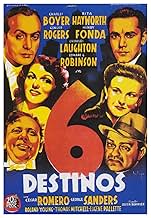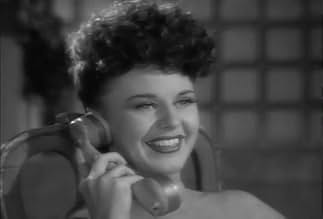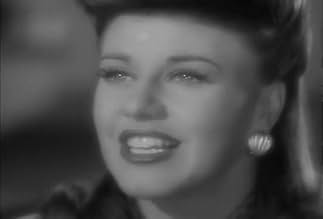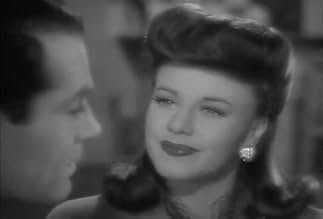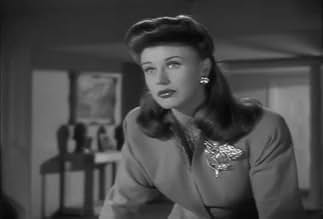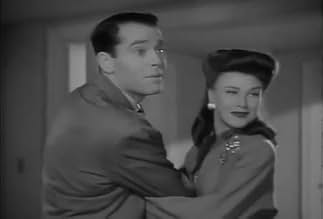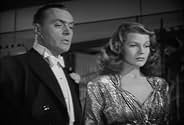AVALIAÇÃO DA IMDb
7,3/10
2,7 mil
SUA AVALIAÇÃO
Adicionar um enredo no seu idiomaA formal tailcoat that gets passed from one owner to another affects each life in a significant way.A formal tailcoat that gets passed from one owner to another affects each life in a significant way.A formal tailcoat that gets passed from one owner to another affects each life in a significant way.
- Direção
- Roteiristas
- Artistas
- Prêmios
- 7 vitórias no total
Avaliações em destaque
This is a clever frame story that follows the "experiences" of a formal tails jacket from the upper crust of the idle rich down through all levels of society. The all-star cast give great performances in five well-written stories.
The film's theme has to do with the American Dream and what it really means. To some it is just social pretense and money. But to others, it is the right to express one's own art, to retain one's dignity, and to live free from fear of poverty.
This is a charming and moving film. Don't pass it up.
The film's theme has to do with the American Dream and what it really means. To some it is just social pretense and money. But to others, it is the right to express one's own art, to retain one's dignity, and to live free from fear of poverty.
This is a charming and moving film. Don't pass it up.
This is one of the better multiple story movies from Hollywood, though it demonstrates the limitations of the genre as well as it's strengths. At it's best, this kind of movie manages to integrate the stories in some way (think of the plot of GRAND HOTEL or DINNER AT EIGHT, where the problems of different groups of characters manage to intertwine in a confined space - another example (though a non-Hollywood film) is the British horror classic DEAD OF NIGHT). Some of the anthology films based on the stories of a particular writer (O'Henry or Somerset Maugham for instance) don't have to blend the stories because of the style of the writer, which unifies the different stories. But then you have a well made film like this one, with a good journeyman director (Jules Duvivier, who had previously done the similar FLESH AND FANTASY), and an all name cast to die for. This is the only film that had Charles Boyer, Rita Hayworth, Thomas Mitchell, Roland Young, Eugene Pallette, Henry Fonda, Ginger Rogers, Cesar Romero, Charles Laughton, Elsa Lanchester, Victor Francken, Edward G. Robinson, James Gleason, George Sanders, W.C.Fields, Margaret Dumont, Phil Silvers, J. Carroll Naish, Paul Robeson, Ethel Waters, Eddie Anderson, and Clarence Muse in one picture - even though they were in different stories.
But the running thread is weak. It is the passing of a "monkey suit" back and forth from one leading character to another - a pun on "tales" and "tails" (which is what such an elaborate tuxedo is called). That the actors who get the "tails" (Boyer, Romero, Laughton, Robinson, Fields) do not fit the same size clothes does not seem to be taken into consideration. Interestingly, Laughton did lose weight for the role, but he still is burlier than Boyer or Romero. As for the final recipients of the "tails" (Naish and Robeson), the former is a crook who wears the suit briefly while pulling off the robbery of a casino, and then uses the suit as a container for the stolen cash, and the latter never cares about the coat, but is mostly concerned with the cash that is dropped down inside it. The "tails" end up being used on a scarecrow on Robeson's farm.
It is a silly device to use, and the ending (an all African-American episode about how a rural town of African - Americans finds the "tails" containing stolen cash (dropped from a plane by J. Carroll Naish). As the characters in the other stories were all whites in the upper classes (even the now impoverished Robinson was once a successful attorney, and Fields is a social climber/ fake lecturer on the dangers of drinking. The Blacks in the film are definitely in the lower classes. What is unique about their segment is that the money that Robeson finds is not kept (as he would have done) by him but split into shares for every Black person in the town - a "Marxist" kind of solution that fits with Robeson's political views in the late 1940s and early 1950s. Dramatically the two best stories are the ones about Robinson pretending that he is not an impoverished bum, when attending the reunion of his college classmates (one of whom, Sanders, is an old rival who suspects the truth), and the first story about the purchase of the cursed set of "tails" by Boyer, and his subsequent discovery of the unworthiness of his lover Hayworth (who is left humiliated with her husband Mitchell). The continental flavor of Boyer's sequence may be the portion of the film based on a script of Ferenc Molnar's. The Laughton sequence is okay, but nothing to rave about (although the role of Victor Francken as the tempermental symphony conductor - who helps Laughton - is a clone of "Toscanini", down to the name of the character - "ARTURO Belini". The weakest is the Fonda - Rogers - Romero sequence, which should have been better (and the fine screen attraction of Fonda and Rogers makes one wish that they made a complete film together - tragically this segment was their only film together). The Naish sequence is too brief to be judged well, though Naish does exude menace as a thief.
That leaves the famous "lost" sequence of Fields and Margaret Dumont. It really was never fully lost - for many years film societies showing "Fields" specialties would show that sequence like a short. But it is not complete as it survives. How did Margaret Dumont get her head stuck in the chandelier that she is wearing? That is not in the final sequence that the video version of the movie includes.
It was their second movie together. Fields own NEVER GIVE A SUCKER AN EVEN BREAK included his romancing Dumont (as the wealthy Mrs. Hemoglobin) despite the rivalry of Leon Erroll. That film was made in 1941, and perhaps Fields suggested reteaming with Dumont. She is a good foil for him, but nothing else (and nobody else) at the lecture is worthy of Fields' typical shafts of wit. The only other to stand out (at all) in the lecture portion of the sequence is Chester Clute, the alcoholic husband of Dumont, and he does not confront Fields.
But earlier in the sequence is a worthy adversary - in fact the only worthy adversary Fields ever had in a congame confrontation: Phil Silvers. As this was one of Fields last movies, it was one of Silvers first films. Television's future "Sergeant Bilko" had begun to perfect his style of flim-flam and fast talk, and it is a treat of sorts watching him con Fields into paying for the "tails" by putting a fake wad of bills in the coat (so Fields thinks he's getting the better of Silvers in the deal). A bit like watching the passing of a crown between champions of their days.
But the running thread is weak. It is the passing of a "monkey suit" back and forth from one leading character to another - a pun on "tales" and "tails" (which is what such an elaborate tuxedo is called). That the actors who get the "tails" (Boyer, Romero, Laughton, Robinson, Fields) do not fit the same size clothes does not seem to be taken into consideration. Interestingly, Laughton did lose weight for the role, but he still is burlier than Boyer or Romero. As for the final recipients of the "tails" (Naish and Robeson), the former is a crook who wears the suit briefly while pulling off the robbery of a casino, and then uses the suit as a container for the stolen cash, and the latter never cares about the coat, but is mostly concerned with the cash that is dropped down inside it. The "tails" end up being used on a scarecrow on Robeson's farm.
It is a silly device to use, and the ending (an all African-American episode about how a rural town of African - Americans finds the "tails" containing stolen cash (dropped from a plane by J. Carroll Naish). As the characters in the other stories were all whites in the upper classes (even the now impoverished Robinson was once a successful attorney, and Fields is a social climber/ fake lecturer on the dangers of drinking. The Blacks in the film are definitely in the lower classes. What is unique about their segment is that the money that Robeson finds is not kept (as he would have done) by him but split into shares for every Black person in the town - a "Marxist" kind of solution that fits with Robeson's political views in the late 1940s and early 1950s. Dramatically the two best stories are the ones about Robinson pretending that he is not an impoverished bum, when attending the reunion of his college classmates (one of whom, Sanders, is an old rival who suspects the truth), and the first story about the purchase of the cursed set of "tails" by Boyer, and his subsequent discovery of the unworthiness of his lover Hayworth (who is left humiliated with her husband Mitchell). The continental flavor of Boyer's sequence may be the portion of the film based on a script of Ferenc Molnar's. The Laughton sequence is okay, but nothing to rave about (although the role of Victor Francken as the tempermental symphony conductor - who helps Laughton - is a clone of "Toscanini", down to the name of the character - "ARTURO Belini". The weakest is the Fonda - Rogers - Romero sequence, which should have been better (and the fine screen attraction of Fonda and Rogers makes one wish that they made a complete film together - tragically this segment was their only film together). The Naish sequence is too brief to be judged well, though Naish does exude menace as a thief.
That leaves the famous "lost" sequence of Fields and Margaret Dumont. It really was never fully lost - for many years film societies showing "Fields" specialties would show that sequence like a short. But it is not complete as it survives. How did Margaret Dumont get her head stuck in the chandelier that she is wearing? That is not in the final sequence that the video version of the movie includes.
It was their second movie together. Fields own NEVER GIVE A SUCKER AN EVEN BREAK included his romancing Dumont (as the wealthy Mrs. Hemoglobin) despite the rivalry of Leon Erroll. That film was made in 1941, and perhaps Fields suggested reteaming with Dumont. She is a good foil for him, but nothing else (and nobody else) at the lecture is worthy of Fields' typical shafts of wit. The only other to stand out (at all) in the lecture portion of the sequence is Chester Clute, the alcoholic husband of Dumont, and he does not confront Fields.
But earlier in the sequence is a worthy adversary - in fact the only worthy adversary Fields ever had in a congame confrontation: Phil Silvers. As this was one of Fields last movies, it was one of Silvers first films. Television's future "Sergeant Bilko" had begun to perfect his style of flim-flam and fast talk, and it is a treat of sorts watching him con Fields into paying for the "tails" by putting a fake wad of bills in the coat (so Fields thinks he's getting the better of Silvers in the deal). A bit like watching the passing of a crown between champions of their days.
This film's cast is so amazing you're going to expect it to be a perfect 10. You will most likely love some vignettes and only like others. You will be glad you watched and will be entertained.
This movie is made up of many vignettes featuring many capable stars--all centering on the same second-hand tuxedo as it is passed on from one owner to the next. I won't try to elaborate on all the segments, as one of the previous reviewers did a very thorough job of describing them. However, they are all extremely well-crafted and engaging. I would also agree that stylistically, this film is reminiscent of IF I HAD A MILLION, though the stories in Tales of Manhattan are generally less funny but more polished.
The one portion of the movie that really stood out for me was the one featuring the down-and-out Edward G. Robinson attending his college class reunion (from Harvard, I think). He goes in a tattered old hand-me-down tux hoping to fool his old chums into thinking he's made it in life. You really feel for the guy in his plight--especially when a mean-spirited member of the class seeks to expose the ruse! So give it a try, why don't ya?
The one portion of the movie that really stood out for me was the one featuring the down-and-out Edward G. Robinson attending his college class reunion (from Harvard, I think). He goes in a tattered old hand-me-down tux hoping to fool his old chums into thinking he's made it in life. You really feel for the guy in his plight--especially when a mean-spirited member of the class seeks to expose the ruse! So give it a try, why don't ya?
The movie's a pretty good look at some of TCF's top stars of the day. The plot amounts to a series of vignettes that follow a dress coat as it gets passed around to a series of new owners. The trouble is the coat is supposed to be cursed so we expect some adversity to befall each new owner. Some vignettes, of course, are better than others. Personally I liked the Rogers- Fonda farcical 20-minutes best. On the other hand, I can see why the WC Fields episode was dropped from many versions since it's not the grouchy comedian at his best. (I also suspect the rather gross anatomical drawing behind his lectern didn't help.)
As a movie, it's certainly different, something of a showcase and, my gosh, was Rita Hayworth ever any lovelier than here. Pairing her with a pixie-ish Thomas Mitchell as a cuckolded husband was a masterstroke. Watch how slyly he asserts himself against the over-confident Boyer. Robinson gets the most extended screen time as a down-and-out lawyer trying to impress his old school chums. I'm just sorry we didn't get to hear more of Paul Robeson's wonderful bass voice in the final darktown jubilee section. Nonetheless, it's a sprightly and satisfying way to end the saga of the accursed dress coat.
The movie comes across today as an exception to the standard studio product, but is cleverly set up with a dash of humor and a touch of timeless human interest.
As a movie, it's certainly different, something of a showcase and, my gosh, was Rita Hayworth ever any lovelier than here. Pairing her with a pixie-ish Thomas Mitchell as a cuckolded husband was a masterstroke. Watch how slyly he asserts himself against the over-confident Boyer. Robinson gets the most extended screen time as a down-and-out lawyer trying to impress his old school chums. I'm just sorry we didn't get to hear more of Paul Robeson's wonderful bass voice in the final darktown jubilee section. Nonetheless, it's a sprightly and satisfying way to end the saga of the accursed dress coat.
The movie comes across today as an exception to the standard studio product, but is cleverly set up with a dash of humor and a touch of timeless human interest.
Você sabia?
- CuriosidadesW.C. Fields appeared in a chapter which was cut from the final theatrical version. It had been restored to the 1996 VHS version. Also in the segment are Margaret Dumont Marcel Dalio, and Phil Silvers. However, when it was later on released in DVD, the Fields segment was deleted again.
- Erros de gravaçãoEven though the audience has seen a close-up of Charles Boyer's bullet wound behind the left side of his jacket, when he turns to say goodbye to Mitchell and Hayworth the left side of the jacket lifts, and there is no bloodstain.
- Citações
Paul Orman: What did you want to say about guns, Mr. Halloway?
John Halloway: Ever use 'em?
Paul Orman: Yes, on the stage.
Paul Orman: Shoot 'em?
John Halloway: On the stage.
John Halloway: Not real bullets?
Paul Orman: No.
John Halloway: Just blanks, eh?
Paul Orman: Yes, only blanks. We actors prefer them.
- Cenas durante ou pós-créditosThe following contains a restored sequence starring W.C. Fields which was not included in the original theatrical release of "Tales of Manhattan."
- Versões alternativasSome scenes featuring W.C. Fields were filmed but cut from the movie before release. The US video version restores this unseen footage. In this 9 minute sequence, Phil Silvers and Marcel Dalio played the Santelli Brothers who owned the used clothing store where Fields bought the dinner jacket. Margaret Dumont played a wealthy woman who hired Fields to give a lecture on the evils of alcohol. The J. Carroll Naish episode was filmed and substituted for the longer Fields episode after it was cut.
- ConexõesFeatured in M*A*S*H: Morale Victory (1980)
- Trilhas sonorasPerpetual Motion (Perpetuum mobile, Op. 257)
(uncredited)
Music by Johann Strauss
Played at the concert hall rehearsal
Principais escolhas
Faça login para avaliar e ver a lista de recomendações personalizadas
- How long is Tales of Manhattan?Fornecido pela Alexa
Detalhes
- Data de lançamento
- País de origem
- Centrais de atendimento oficiais
- Idioma
- Também conhecido como
- Tales of Manhattan
- Locações de filme
- Empresa de produção
- Consulte mais créditos da empresa na IMDbPro
Bilheteria
- Orçamento
- US$ 1.000.000 (estimativa)
- Tempo de duração1 hora 58 minutos
- Cor
- Proporção
- 1.37 : 1
Contribua para esta página
Sugerir uma alteração ou adicionar conteúdo ausente

Principal brecha
By what name was Seis Destinos (1942) officially released in Canada in English?
Responda
